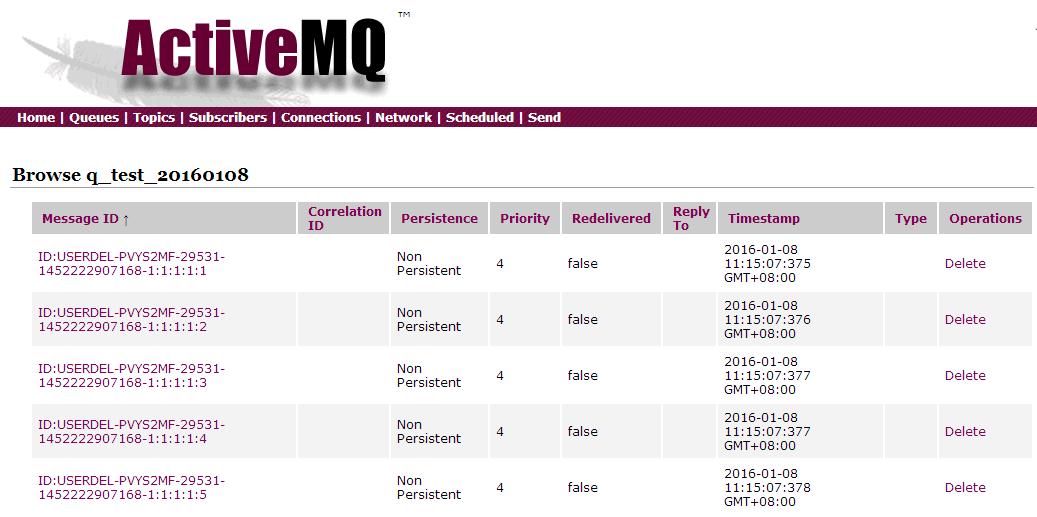接上篇 JMS笔记(一),启动ActiveMQ后,打开http://127.0.0.1:8161/admin管理界面,用户名admin密码admin,点击上面的Queues菜单,创建一个q_test_20160108,之后就可以向这个queue写东西了
1. P2P模式
生产者示例代码:
@Test public void testActiveMqSend(){ // ConnectionFactory :连接工厂,JMS 用它创建连接 ConnectionFactory connectionFactory; // Connection :JMS 客户端到JMS Provider 的连接 Connection connection = null; // Session: 一个发送或接收消息的线程 Session session; // Destination :消息的目的地;消息发送给谁. Destination destination; // MessageProducer:消息发送者 MessageProducer producer; // TextMessage message; // 构造ConnectionFactory实例对象,此处采用ActiveMq的实现jar connectionFactory = new ActiveMQConnectionFactory( ActiveMQConnection.DEFAULT_USER, ActiveMQConnection.DEFAULT_PASSWORD, "tcp://127.0.0.1:61616"); try { // 构造从工厂得到连接对象 connection = connectionFactory.createConnection(); // 启动 connection.start(); // 获取操作连接 session = connection.createSession(Boolean.TRUE, Session.AUTO_ACKNOWLEDGE); // 获取session注意参数值q_test_20160108是一个服务器的queue,须在在ActiveMq的console配置 destination = session.createQueue("q_test_20160108"); // 得到消息生成者【发送者】 producer = session.createProducer(destination); // 设置不持久化,实际根据项目决定 producer.setDeliveryMode(DeliveryMode.NON_PERSISTENT); // 构造消息, sendMessage(session, producer); session.commit(); } catch (Exception e) { e.printStackTrace(); } finally { try { if (null != connection) connection.close(); } catch (Throwable ignore) { } } } private static final int SEND_NUMBER = 5; public static void sendMessage(Session session, MessageProducer producer) throws Exception { for (int i = 1; i <= SEND_NUMBER; i++) { TextMessage message = session.createTextMessage("ActiveMq 发送的消息" + i); // 发送消息到目的地方 System.out.println("发送消息:" + "ActiveMq 发送的消息" + i); producer.send(message); } }
运行完以上代码去管理界面查看q_test_20160108

消费者示例代码:
@Test public void testActiveMqReceive(){ // ConnectionFactory :连接工厂,JMS 用它创建连接 ConnectionFactory connectionFactory; // Connection :JMS 客户端到JMS Provider 的连接 Connection connection = null; // Session: 一个发送或接收消息的线程 Session session; // Destination :消息的目的地;消息发送给谁. Destination destination; // 消费者,消息接收者 MessageConsumer consumer; connectionFactory = new ActiveMQConnectionFactory( ActiveMQConnection.DEFAULT_USER, ActiveMQConnection.DEFAULT_PASSWORD, "tcp://127.0.0.1:61616"); try { // 构造从工厂得到连接对象 connection = connectionFactory.createConnection(); // 启动 connection.start(); // 获取操作连接 session = connection.createSession(Boolean.FALSE, Session.AUTO_ACKNOWLEDGE); // 获取session注意参数值q_test_20160108是一个服务器的queue,须在在ActiveMq的console配置 destination = session.createQueue("q_test_20160108"); consumer = session.createConsumer(destination); while (true) { //设置接收者接收消息的时间,为了便于测试,这里设定为100s TextMessage message = (TextMessage) consumer.receive(100000); if (null != message) { System.out.println("收到消息" + message.getText()); } else { break; } } } catch (Exception e) { e.printStackTrace(); } finally { try { if (null != connection) connection.close(); } catch (Throwable ignore) { } } }
以上代码去mq取消息,运行完之后,再去管理界面查看q_test_20160108,刚刚的消息没有了,但是能够看到统计,有多少消息进来,多少消息出去,当前还有多少消息
,当前多少消费者等

2. pub/sub模式
发布者示例:
@Test public void testActiveMqSend(){ // ConnectionFactory :连接工厂,JMS 用它创建连接 ConnectionFactory connectionFactory; // Connection :JMS 客户端到JMS Provider 的连接 Connection connection = null; // Session: 一个发送或接收消息的线程 Session session; // Destination :消息的目的地;消息发送给谁. Destination destination; // MessageProducer:消息发送者 MessageProducer producer; // TextMessage message; // 构造ConnectionFactory实例对象,此处采用ActiveMq的实现jar connectionFactory = new ActiveMQConnectionFactory( ActiveMQConnection.DEFAULT_USER, ActiveMQConnection.DEFAULT_PASSWORD, "tcp://127.0.0.1:61616"); try { // 构造从工厂得到连接对象 connection = connectionFactory.createConnection(); // 启动 connection.start(); // 获取操作连接 session = connection.createSession(Boolean.TRUE, Session.AUTO_ACKNOWLEDGE); destination = session.createTopic("topic_1"); // 得到消息生成者【发送者】 producer = session.createProducer(destination); // 设置不持久化,此处学习,实际根据项目决定 producer.setDeliveryMode(DeliveryMode.NON_PERSISTENT); // 构造消息,此处写死,项目就是参数,或者方法获取 sendMessage(session, producer); session.commit(); } catch (Exception e) { e.printStackTrace(); } finally { try { if (null != connection) connection.close(); } catch (Throwable ignore) { } } } private static final int SEND_NUMBER = 5; public static void sendMessage(Session session, MessageProducer producer) throws Exception { for (int i = 1; i <= SEND_NUMBER; i++) { TextMessage message = session.createTextMessage("ActiveMq 发送的消息" + i); // 发送消息到目的地方 System.out.println("发送消息:" + "ActiveMq 发送的消息" + i); producer.send(message); } }
执行完以上语句,在管理界面点击topics菜单,可以看到topic_1
订阅者示例:
@Test public void testActiveMqReceive(){ // ConnectionFactory :连接工厂,JMS 用它创建连接 ConnectionFactory connectionFactory; // Connection :JMS 客户端到JMS Provider 的连接 Connection connection = null; // Session: 一个发送或接收消息的线程 Session session; // Destination :消息的目的地;消息发送给谁. Destination destination; // 消费者,消息接收者 MessageConsumer consumer; connectionFactory = new ActiveMQConnectionFactory( ActiveMQConnection.DEFAULT_USER, ActiveMQConnection.DEFAULT_PASSWORD, "tcp://127.0.0.1:61616"); try { // 构造从工厂得到连接对象 connection = connectionFactory.createConnection();
//持久化订阅必须使用下语句!!!!参数是clientid connection.setClientID("mysub_3"); // 启动 connection.start(); // 获取操作连接 session = connection.createSession(Boolean.FALSE, Session.AUTO_ACKNOWLEDGE); destination = session.createTopic("topic_1"); //consumer = session.createConsumer(destination);普通订阅
//持久化订阅!!!第二个参数是clientid consumer = session.createDurableSubscriber((Topic) destination,"mysub_3"); while (true) { //设置接收者接收消息的时间,为了便于测试,这里设定为100s TextMessage message = (TextMessage) consumer.receive(100000); if (null != message) { System.out.println("收到消息" + message.getText()); } else { break; } } } catch (Exception e) { e.printStackTrace(); } finally { try { if (null != connection) connection.close(); } catch (Throwable ignore) { } } }
发现一个问题,运行以上代码,不能收到topic_1上的消息,开始一直以为有什么东西有问题,纠结了一阵子,后来想通了,对持久订阅理解不对,持久订阅从你订阅开始收到消息,离线了,然后在上线,期间的消息是可以收到了,但是你订阅之前的就不能收到了
在管理界面Subscribers菜单下可以看到订阅者列表

参考文章